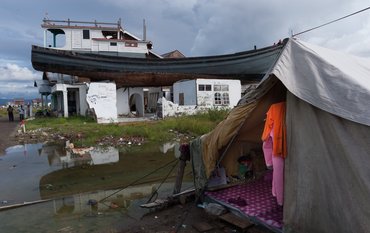River beds that can shift naturally are more efficient carbon sinks than straightened rivers
It takes about 8500 years for a grain of sand from the Andes to be washed across the Argentine lowlands into the Río Paraná. The 1200-kilometer journey in the river called Río Bermejo is interrupted by many stops in river floodplains, where the grain is deposited, sometimes over thousands of years, and then washed free again. The sand is accompanied by organic carbon, washed in from soil and plants. The transport in water thus gains relevance for the climate: Rivers carry the carbon, which was previously removed from the atmosphere via photosynthesis, as sediment into the sea, where it is stored for thousands of years without harming the climate.
Researchers at the GFZ German Research Centre for Geosciences have now quantified the individual processes of the journey for the first time and report on them in the journal Nature Geoscience. An important result of the work: It is in particular undisturbed meandering sections of a river where carbon is deposited and reabsorbed, and then transported further into the sea. In river sections with straight, stable banks, on the other hand, only the suspended particle load passes through, while the carbon in the river floodplains is slowly decomposed again to CO2 by microorganisms. GFZ working group leader Dirk Sachse says, "The Río Bermejo was an ideal natural laboratory for us because it has no significant tributaries." Sachse is also director of the "Landscapes of the Future" topic in the Helmholtz program "Changing Earth – Sustaining Our Future." He says, "This means that natural river courses that have space to erode floodplains can remove more carbon from the atmosphere than straight river sections. In this respect, straightening of rivers by humans could also contribute to the increase in atmospheric CO2 concentration. What's exciting now is answering the question of whether we can help the climate by giving rivers more space again and not impeding natural river meandering."
The international team led by first author Marisa Repasch of GFZ studied the processes in the river and its floodplains with a diverse set of instruments. Analyses of cosmogenic beryllium-10 content, for example, indicated the duration of sediment transport. Dating based on the unstable carbon isotope 14C, in turn, allowed conclusions to be drawn about the age of the particles of organic origin. During fieldwork in Argentina, samples were taken from the river at multiple stations along the source-to-sink pathway. "Naturally meandering rivers erode material from floodplains and transport it to the sea, where it remains for a long time," says Marisa Repasch, summarizing the results, "in contrast, artificially stabilized river courses are far less effective carbon sinks."
Original study: Marisa Repasch, Joel S. Scheingross, Niels Hovius, Maarten Lupker, Hella Wittmann, Negar Haghipour, Darren R. Gröcke, Oscar Orfeo, Timothy I. Eglinton, and Dirk Sachse: Fluvial organic carbon cycling regulated by sediment transit time and mineral protection; in: Nature Geoscience DOI: 10.1038/s41561-021-00845-7
Scientific contacts:
Marisa Repasch
E-mail: marisa.nicole.repasch@gfz-potsdam.de
Now (in the US): repasch1@llnl.gov
Dr. Dirk Sachse
Section Geomorphology
Tel: 0331 28828823
E-mail: dirk.sachse@gfz-potsdam.de
Media contact:
Josef Zens
Head of Public and Media Relations
Tel.: 0331-288-1040
E-mail: josef.zens@gfz-potsdam.de














![[Translate to English:] [Translate to English:] Abror Gafurov von dem Schriftzug "Welcome to Azerbaijan" und den UN und COP Logos](/fileadmin/_processed_/2/5/csm_2024_11_Baku_COP29_Abror_Gafurov_1042faec82.jpeg)


![[Translate to English:] Martin Herold standing in front of the library on the Telegrafenberg](/fileadmin/_processed_/c/d/csm_Martin_Herold_d385ee4dd9.jpeg)
![[Translate to English:] Many people are listening to a presentation in the GFZ lecture hall.](/fileadmin/_processed_/c/a/csm_1_Bild1_hell_b9c0e9f5ed.jpeg)






![[Translate to English:] Both scientists sitting on stools in front of a wall of books in the Telegrafenberg library](/fileadmin/_processed_/6/6/csm_Buiter_Castell_DORA_4_e87cb1ea18.jpeg)
![[Translate to English:] Gruppenbild mit 4 Personen](/fileadmin/_processed_/8/d/csm_20241017_GFZ-Emmerman-Medal-005_web_reinhardtundsommer_21a414fa4a.jpeg)






![[Translate to English:] Ice landscape with five red tents](/fileadmin/_processed_/8/9/csm_Zeltlager_auf_dem_Eis_Urheberin_Jenine_McCutcheon_5ced2d523b.jpeg)

